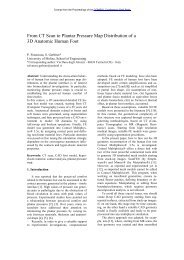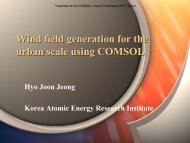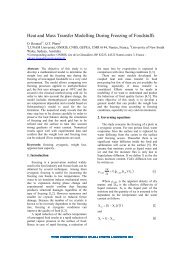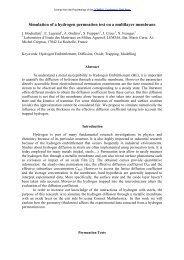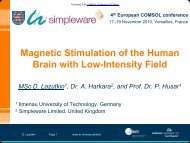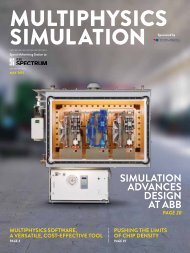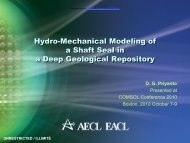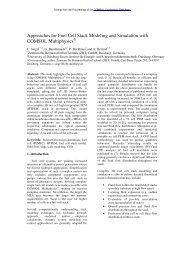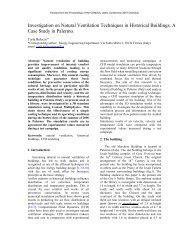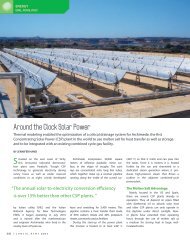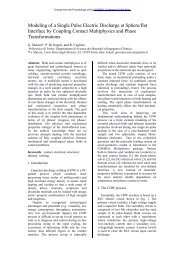Ultrasonic Testing - COMSOL.com
Ultrasonic Testing - COMSOL.com
Ultrasonic Testing - COMSOL.com
Create successful ePaper yourself
Turn your PDF publications into a flip-book with our unique Google optimized e-Paper software.
Excerpt from the Proceedings of the 2012 <strong>COMSOL</strong> Conference in MilanCalibration of <strong>Ultrasonic</strong> <strong>Testing</strong>for faults detection in stone masonryM. Usai 1 , S. Carcangiu 1 , and G. Concu 21Department of Electric and Electronic Engineering2Department of Civil Engineering, Environmental and ArchitectureUniversity of Cagliari, Sardinia, Italy<strong>COMSOL</strong> CONFERENCE EUROPE 2012
• IntroductionNon-Destructive <strong>Testing</strong><strong>Ultrasonic</strong> <strong>Testing</strong>• Experimental sessionOutline• Simulations with <strong>COMSOL</strong> Multiphisycs• Comparison between experimental and simulated data• Results and conclusions<strong>COMSOL</strong> CONFERENCE EUROPE 2012
IntroductionThe Research Group in Electrical Engineering of Cagliari, withcolleagues of the Department of Civil Engineering, hasdeveloped skills and knowledge in the field of signalprocessing in Non-Destructive-<strong>Testing</strong>-Techniques NDTs onhomogeneous materials (metals) and non-homogeneousmaterials (building materials).<strong>COMSOL</strong> CONFERENCE EUROPE 2012
IntroductionIn the field of assessment methodologies, particularimportance is given to Non-Destructive-<strong>Testing</strong>-Techniques NDTs,which aspire to achieve the highest number of information aboutmaterials and structures without altering their condition.The implementation of algorithms for signals post-processingconsists in extracting information from test signals derived fromthe non-destructive tests.<strong>COMSOL</strong> CONFERENCE EUROPE 2012
Non-Destructive <strong>Testing</strong>Among NDTs, <strong>Ultrasonic</strong> <strong>Testing</strong> exploits the transmission andreflection characteristics of mechanical waves with appropriatefrequencies passing through the investigated item.EMITTER TRANSDUCERWALLPULSERRECEIVERRECEIVER TRANSDUCERDIGITALOSCILLOSCOPE<strong>COMSOL</strong> CONFERENCE EUROPE 2012
<strong>Ultrasonic</strong> <strong>Testing</strong>Elastic waves propagate in different manner through solidmaterials and cavities, thus enabling fault detection.For example, the figure shows how in the presence of a fault,the transmitted wave gives rise to a signal of lower amplitude.<strong>COMSOL</strong> CONFERENCE EUROPE 2012
<strong>Ultrasonic</strong> <strong>Testing</strong>The testing method is the Direct Transmission Technique (EN14579 2004).In this method, the ultrasonic wave is transmitted by a transducer(Transmitter) through the test object and received by a secondtransducer (Receiver) on the opposite side of the structure.<strong>COMSOL</strong> CONFERENCE EUROPE 2012
<strong>Ultrasonic</strong> <strong>Testing</strong>Due to media dissipative effect, elastic waves are strongly attenuatedthe emission cone of the signal source can be less divergent as possible.Acoustic field of the transducerThe sound field of a transducer is divided into two zones: the near field and the far field.Near field: region directly in front of the transducer where the amplitudegoes through a series of maxima and minima and ends at the last maximum,at distance N from the transducer.Far field: area beyond N, where the sound field pressuregradually drops to zero.Because of the variations within the near fieldit can be difficult to accurately evaluate flawsusing amplitude based techniques.D diameter of the Transducer sourceλ wavelength of the waveN 2D4λ Near field distance<strong>COMSOL</strong> CONFERENCE EUROPE 2012
<strong>Ultrasonic</strong> <strong>Testing</strong>Due to media dissipative effect, elastic waves are strongly attenuatedthe emission cone of the signal source can be less divergent as possible.Beam Spread and Half AngleAll ultrasonic beams divergethe beam spread is a function of wavelength1.2sin DIf D >> λ the wave is emitted with a not very divergent cone.As λ is in inverse proportion to frequency f, it is understandable howhigh frequency signals enable waves to be highly directional.<strong>COMSOL</strong> CONFERENCE EUROPE 2012
<strong>Ultrasonic</strong> <strong>Testing</strong>These studies need the highest number of signals as possible.Laboratory tests must be accurate and repeated several times toobtain reliable signals.↓In this phase of the work be<strong>com</strong>es important to simulateeffectively the real models with a suitable FEM code.<strong>COMSOL</strong> CONFERENCE EUROPE 2012
Experimental sessionFront view of the wallHorizontal plane sectionVertical plane sectionThe <strong>Ultrasonic</strong> Techniquehas been carried out on atrachyte stone masonrywith a cavity inside.<strong>COMSOL</strong> CONFERENCE EUROPE 2012
Experimental sessionThe wall is 90 cm wide, 62 cmhigh and 38 cm thick, and it ismade of trachyte blocks sized20 × 38 × 12 cm 3 joined withmortar.To map the faults308 points for the emittertransducer and 308 pointsfor the receiver transducerhave been arranged in a gridof 14 x 22 nodes in theopposite surfaces of the wall.<strong>COMSOL</strong> CONFERENCE EUROPE 2012
Experimental set-up<strong>Ultrasonic</strong> measurements have been carried out using theultrasonic test equipment Pundit Lab+, developed byProceq, with standard 54 KHz transducers .<strong>COMSOL</strong> CONFERENCE EUROPE 2012
Voltage [V]Experimental sessionThe energizing signal is a square wave with high input voltage of 500 V,which develops in a time interval of 9.3μs.The high intensity of this signal allowed signals on the other side of the wall to bedetected even if strongly attenuated.<strong>COMSOL</strong> CONFERENCE EUROPE 2012
Experimental sessionA signal has been acquired in each point of the grid of receivers. From each node ofthe grid, several features in both time and frequency domain can been extracted.Time domain• Propagation velocity• Maximum peak-peak amplitude• Maximum absolute amplitude• Minimum absolute amplitude• Mean value of normalized amplitude• Variance of normalized amplitude• Time–reversibility• Third order auto-covariance• Mean value of normalized signal envelope• Variance of normalized signal envelope• Local rise time from 25% level to peak ofnormalized signal envelope• Local rise time from 50% level to peak ofnormalized signal envelope• Signal power• Travel timeFrequency Domain• Spectrum principal frequency• Spectrum normalized maximum amplitude• Input signal attenuation• Spectrum central frequency• Spectrum Bandwidth• Spectrum normalized mean value• Spectrum normalized varianceSome of the features that are normally considered to extract information about faults from the signal<strong>COMSOL</strong> CONFERENCE EUROPE 2012
Experimental sessionReceived signals have different patterns depending on the nature of the materials crossed.It is possible to distinguish different typesof signal paths, corresponding to differentmaterials regions in the wall :trachyte path (pale blue) 2trachyte-mortar path (yellow) 1 and 3trachyte-mortar-air path (brown) 4Map associated to the different materialswhich make up the wall.<strong>COMSOL</strong> CONFERENCE EUROPE 2012
Experimental signals crossing the 4 paths (Time domain)To different pathscorrespond differentsignals with unlikeamplitudesandharmonic content.12Due to edge effects,signals travellingclose to the boundaryof a material regionare different fromthose crossing theinner part of thesame region.3 4<strong>COMSOL</strong> CONFERENCE EUROPE 2012
Spectra(Frequencydomain)The harmoniccontent of thesignals takes placearound theresonant frequencyof thetransducer (54 KHz)and differs for eachpath.1324<strong>COMSOL</strong> CONFERENCE EUROPE 2012
Simulations with <strong>COMSOL</strong> MultiphisycsThe numerical analyses have performed using a Pressure Acoustics model and thePiezoelectric Devices Interface belonging to the <strong>COMSOL</strong> Acoustics Module.In order to decrease the size of the resolution matrices, with significant reduction ofprocessing time and <strong>com</strong>putational errors :the frequency domain rather than the time domain has been chosen to solve themodel. The sound field is described and solved by the pressure p, so we cansimulate only one transducer (the emitter)two sub-models coupled using the Extrusion Model Couplings option of <strong>COMSOL</strong>have been considered:one for the emission transducer (2D axisymmetric) and another for the wall (3D).<strong>COMSOL</strong> CONFERENCE EUROPE 2012
Simulations with <strong>COMSOL</strong> MultiphisycsThe wall and the emitter transducer have been simulated with two submodels<strong>COMSOL</strong> CONFERENCE EUROPE 2012
Simulations with <strong>COMSOL</strong> MultiphisycsTwo sub-models coupledWall model (3D)Emission transducer model(2D axisymmetric)<strong>COMSOL</strong> CONFERENCE EUROPE 2012
Simulations with <strong>COMSOL</strong> MultiphisycsThe sound field is described and solved by the pressure p.The acoustic pressure in the time domain p(t) is obtained as a function of the spectral<strong>com</strong>ponents as:pfNt p f cos2f t p f i fi1minampfmaxiphaseiN number of <strong>com</strong>ponents of the spectra in the frequency range<strong>COMSOL</strong> CONFERENCE EUROPE 2012
Simulations with <strong>COMSOL</strong> MultiphisycsAnalytic model of Pressure Acoustics, Frequency Domain interfaceThe acoustic pressure p(t ) in a medium is governed by the following equationthat is an inhomogeneous Helmholtz equation:1 pkteqcpptp2 c b; k• ρ is the density of the material [kg/m 3 ],• c is the speed of sound [m/s];• Q [1/s 2 ] is a monopole acoustic sourcek2eqptc c Qj; ccc2c2<strong>COMSOL</strong> CONFERENCE EUROPE 2012
Simulations with <strong>COMSOL</strong> MultiphisycsAnalytic model of Piezoelectric Devices interfaceThe mathematical formulation of this model is described by the equations:2 u D VF evjwhere• F v is deformation gradient,• ρ V is the volume charge density,• u is the displacement,• D is the electric displacement and• σ is the stress-charge.<strong>COMSOL</strong> CONFERENCE EUROPE 2012
Simulations with <strong>COMSOL</strong> MultiphisycsAt the interface between the transducer and the wall, the boundarycondition for the acoustics interface is that the pressure is equal to thenormal acceleration of the solid domain: 1n 0p anwhere a n is the normal acceleration.This drives the pressure in the wall domain.<strong>COMSOL</strong> CONFERENCE EUROPE 2012
Simulations with <strong>COMSOL</strong> MultiphisycsThe implementation of the Comsol Model hasrequired a series of simulations to develop all theparameters, until than the results wereconsistent with the experimental ones.<strong>COMSOL</strong> CONFERENCE EUROPE 2012
Simulated signals crossing the 4 paths (Time domain)Simulated signalsshow aperformance ingood agreementwith experimentalsignals12Amplitudes in thetime domain arescaled to theaverage gain of theemissiontransducer3 4<strong>COMSOL</strong> CONFERENCE EUROPE 2012
Simulated Spectra (Frequency domain)Spectral bandwidthare shifted tohigher values , asexpected1234<strong>COMSOL</strong> CONFERENCE EUROPE 2012
ResultsSimilarly to what is found for the measured signals:also the simulated signals present different performances for thedifferent types of paths both in time and frequency domain, andthis allows to post-process them to map the macro defects.<strong>COMSOL</strong> CONFERENCE EUROPE 2012
ConclusionsThe purpose of this work was to create a model of a prototype of a trachyte wall, builtand tested in the laboratory, in order to simulate the ultrasonic signal propagation andthus be able to perform parametric studies freed from the experimental sessions.Model calibration has been achieved by <strong>com</strong>parison of a significant sample ofsimulated signal to the correspondent signals obtained from the experimental sessionsResults show that the implemented <strong>COMSOL</strong> model is suitable to effectively simulatethe ultrasonic signals transmission through the stone wallThe simulated signals can be used to obtain, through post-processing analysis, mapsfor detecting the presence of macro defects with cluster algorithms or non supervisedNeural Networks as Self organizing Maps (SOM)<strong>COMSOL</strong> CONFERENCE EUROPE 2012
ConclusionsThe purpose of this work was to create a model of a prototype of a trachyte wall, builtand tested in the laboratory, in order to simulate the ultrasonic signal propagation andthus be able to perform parametric studies freed from the experimental sessions.Model calibration has been achieved by <strong>com</strong>parison of a significant sample ofsimulated signal to the correspondent signals obtained from the experimental sessionsResults show that the implemented <strong>COMSOL</strong> model is suitable to effectively simulatethe ultrasonic signals transmission through the stone wallThe simulated signals can be used to obtain, through post-processing analysis, mapsfor detecting the presence of macro defects with cluster algorithms or non supervisedNeural Networks as Self organizing Maps (SOM)<strong>COMSOL</strong> CONFERENCE EUROPE 2012
Thanks for your kind attentionFor further information:musai@diee.unica.its.carcangiu@diee.unica.it<strong>COMSOL</strong> CONFERENCE EUROPE 2012
Thanks for your kind attentionThanks for your kind attentionCagliari<strong>COMSOL</strong> CONFERENCE EUROPE 2012




![[PDF] Comsol conference proceedings ... - COMSOL.com](https://img.yumpu.com/50379146/1/190x245/pdf-comsol-conference-proceedings-comsolcom.jpg?quality=85)
